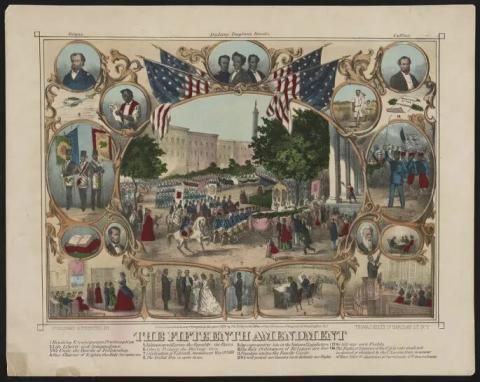

Amendment Fifteen to the Constitution – the last of the Reconstruction Amendments – was ratified on February 3, 1870. It grants the right to vote for all male citizens regardless of their ethnicity or prior slave status. The official text is written as such:
The right of citizens of the United States to vote shall not be denied or abridged by the United States or by any State on account of race, color, or previous condition of servitude.
The Congress shall have the power to enforce this article by appropriate legislation.
Although the right to vote is commonly regarded in modern times to be one of the most important American freedoms, the ability to have a role in elections is something that has been contested since the nation’s founding. When the Constitution and the Bill of Rights was enacted into law in the late 18th century, the Founders’ approach to voting was that each of the states would determine the voter eligibility of their citizens. The most common measurement for voter eligibility in the first decades of the republic was that the prospective voter had to be a white male who owned property of a certain dollar value. Certain states and cities allowed free African Americans and women to vote, but these were few in number and scattered across the Northern states. It would not be until the Presidential Election of 1828 when the majority of the land-ownership requirements were eliminated, and it was twenty-eight years after that when every state removed them. With the passage of the Thirteenth and Fourteenth Amendments after the Civil War, the expansion of civil rights to the newly-freed African American population turned to the question of voting. After the election of Ulysses S. Grant to the presidency in 1868, Congress proposed a new amendment that would ban all restrictions on the right to vote regarding ethnicity and prior slave status. In spite of heavy opposition by the Southern delegations, Congress ratified the Fifteenth Amendment on February 3, 1870. At the start, the amendment did not extend the right to vote to any women in the United States. It would not be until the ratification of the Nineteenth Amendment in 1920 that allowed all women the right to vote.
In spite of the significant impact of the Fifteenth Amendment and its two predecessors, the right to vote was interpreted relatively narrowly by the Supreme Court throughout the late 19th and mid 20th centuries. The 1876 Supreme Court case of United States v. Reese determined that the Fifteenth Amendment did not grant the right to vote, but rather prohibited its restriction. This, in part, led to the rise of “Jim Crow” laws in the Southern states. These undermined many of the newly-achieved constitutional liberties granted to the African American population, including that of voting. Because of discriminatory practices and laws such as poll taxes, literary tests, grandfather clauses, and the newly-formed Ku Klux Klan terrorizing dissenters, many African Americans in the Southern states were unable to exercise their constitutional rights. By the 20th century, the overwhelming majority of African Americans in the South had little to no electoral power. The discriminatory laws and restrictions on voting rights were slowly eroded by a series of Supreme Court decisions in the first half of the 20th century. Guinn v. United States in 1915 determined that the grandfather clause was unconstitutional, and the “Texas primary cases” from 1927 to 1953 slowly eliminated White-only primary elections. The Twenty-fourth Amendment in 1962 eliminated all poll taxes in federal elections, and the Voting Rights Act of 1965 eliminated all forms of discrimination in federal, state, and local elections. At the time of its creation, the Fifteenth Amendment granted the right to vote to a newly-freed population. The century that followed its ratification saw it being used to extend the franchise to all Americans.